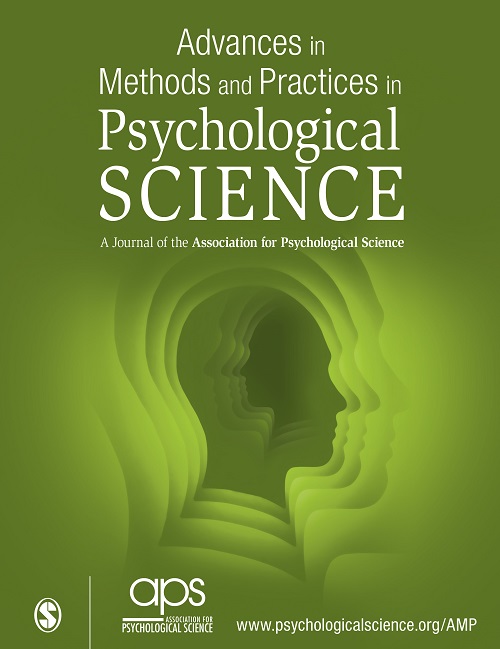PsyCalibrator:一个用于显示器伽马校准、亮度和颜色测量的开源软件包
IF 13.4
1区 心理学
Q1 PSYCHOLOGY
Advances in Methods and Practices in Psychological Science
Pub Date : 2023-04-01
DOI:10.1177/25152459221151151
引用次数: 1
摘要
视觉、心理学和神经科学的研究经常在数字屏幕上呈现视觉刺激。至关重要的是,视觉刺激的外观取决于亮度和颜色等特性,因此测量它们至关重要。然而,传统的亮度测量设备不仅昂贵,而且操作起来也很麻烦(尤其是对于新手来说)。在之前工作的基础上,我们提出了一个开源集成软件包——PsyCalibrator(https://github.com/yangzhangpsy/PsyCalibrator)--它利用了消费者硬件(SpyderX、Spyder5),并使亮度/颜色测量和伽马校准变得容易和灵活。还实施了基于视觉方法(无光度计)的伽马校准。PsyCalibrator需要MATLAB(或其免费替代品GNU Octave),可在Windows、macOS和Linux中工作。我们首先通过将SpyderX和Spyder5的测量值与专业的高成本光度计(ColorCAL MKII 色度计和照片研究PR-670 SpectraScan)。验证结果表明(a)线性校正和亮度/颜色测量具有良好的准确性,(b)出于实际目的,测量方差较低。我们提供了关于使用PsyCalibrator测量亮度/颜色和校准显示器的详细教程。最后,我们建议使用报告模板来描述简单(例如,计算机生成的形状)和复杂(例如,自然图像和视频)的视觉刺激。本文章由计算机程序翻译,如有差异,请以英文原文为准。
PsyCalibrator: An Open-Source Package for Display Gamma Calibration and Luminance and Color Measurement
Studies in vision, psychology, and neuroscience often present visual stimuli on digital screens. Crucially, the appearance of visual stimuli depends on properties such as luminance and color, making it critical to measure them. Yet conventional luminance-measuring equipment is not only expensive but also onerous to operate (particularly for novices). Building on previous work, here we present an open-source integrated software package—PsyCalibrator (https://github.com/yangzhangpsy/PsyCalibrator)—that takes advantage of consumer hardware (SpyderX, Spyder5) and makes luminance/color measurement and gamma calibration accessible and flexible. Gamma calibration based on visual methods (without photometers) is also implemented. PsyCalibrator requires MATLAB (or its free alternative, GNU Octave) and works in Windows, macOS, and Linux. We first validated measurements from SpyderX and Spyder5 by comparing them with professional, high-cost photometers (ColorCAL MKII Colorimeter and Photo Research PR-670 SpectraScan). Validation results show (a) excellent accuracy in linear correction and luminance/color measurement and (b) for practical purposes, low measurement variances. We offer a detailed tutorial on using PsyCalibrator to measure luminance/color and calibrate displays. Finally, we recommend reporting templates to describe simple (e.g., computer-generated shapes) and complex (e.g., naturalistic images and videos) visual stimuli.
求助全文
通过发布文献求助,成功后即可免费获取论文全文。
去求助
来源期刊
CiteScore
21.20
自引率
0.70%
发文量
16
期刊介绍:
In 2021, Advances in Methods and Practices in Psychological Science will undergo a transition to become an open access journal. This journal focuses on publishing innovative developments in research methods, practices, and conduct within the field of psychological science. It embraces a wide range of areas and topics and encourages the integration of methodological and analytical questions.
The aim of AMPPS is to bring the latest methodological advances to researchers from various disciplines, even those who are not methodological experts. Therefore, the journal seeks submissions that are accessible to readers with different research interests and that represent the diverse research trends within the field of psychological science.
The types of content that AMPPS welcomes include articles that communicate advancements in methods, practices, and metascience, as well as empirical scientific best practices. Additionally, tutorials, commentaries, and simulation studies on new techniques and research tools are encouraged. The journal also aims to publish papers that bring advances from specialized subfields to a broader audience. Lastly, AMPPS accepts Registered Replication Reports, which focus on replicating important findings from previously published studies.
Overall, the transition of Advances in Methods and Practices in Psychological Science to an open access journal aims to increase accessibility and promote the dissemination of new developments in research methods and practices within the field of psychological science.

 求助内容:
求助内容: 应助结果提醒方式:
应助结果提醒方式:


